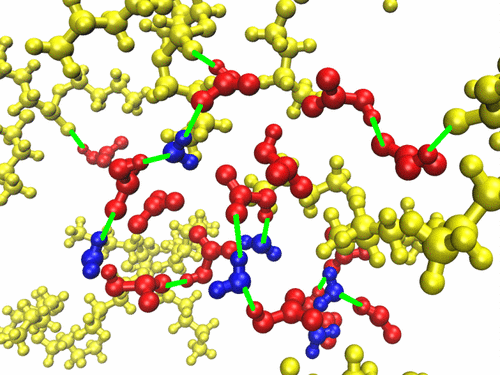当前位置:
X-MOL 学术
›
J. Phys. Chem. B
›
论文详情
Our official English website, www.x-mol.net, welcomes your
feedback! (Note: you will need to create a separate account there.)
A Novel Microemulsion Phase Transition: Toward the Elucidation of Third-Phase Formation in Spent Nuclear Fuel Reprocessing
The Journal of Physical Chemistry B ( IF 2.8 ) Pub Date : 2018-01-18 00:00:00 , DOI: 10.1021/acs.jpcb.7b08515 Junju Mu 1 , Ryuhei Motokawa 2 , Kazuhiro Akutsu 3 , Shotaro Nishitsuji 4 , Andrew J. Masters 1
The Journal of Physical Chemistry B ( IF 2.8 ) Pub Date : 2018-01-18 00:00:00 , DOI: 10.1021/acs.jpcb.7b08515 Junju Mu 1 , Ryuhei Motokawa 2 , Kazuhiro Akutsu 3 , Shotaro Nishitsuji 4 , Andrew J. Masters 1
Affiliation

|
We present evidence that the transition between organic and third phases, which can be observed in the plutonium uranium reduction extraction (PUREX) process at high metal loading, is an unusual transition between two isotropic bicontinuous microemulsion phases. As this system contains so many components, however, we have been seeking first to investigate the properties of a simpler system, namely, the related metal-free, quaternary water/n-dodecane/nitric acid/tributyl phosphate (TBP) system. This quaternary system has been shown to exhibit, under appropriate conditions, three coexisting phases: a light organic phase, an aqueous phase, and the so-called third phase. In the current work, we focused on the coexistence of the light organic phase with the third phase. Using Gibbs ensemble Monte Carlo (GEMC) simulations, we found coexistence of a phase rich in nitric acid and dilute in n-dodecane (the third phase) with a phase more dilute in nitric acid but rich in n-dodecane (the light organic phase). The compositions and densities of these two coexisting phases determined using the simulations were in good agreement with those determined experimentally. Because such systems are generally dense and the molecules involved are not simple, the particle exchange rate in their GEMC simulations can be rather low. To test whether a system having a composition between those of the observed third and organic phases is indeed unstable with respect to phase separation, we used the Bennett acceptance ratio method to calculate the Gibbs energies of the homogeneous phase and the weighted average of the two coexisting phases, where the compositions of these phases were taken both from experimental results and from the results of the GEMC simulations. Both demixed states were determined to have statistically significant lower Gibbs energies than the uniform, mixed phase, providing confirmation that the GEMC simulations correctly predicted the phase separation. Snapshots from the simulations and a cluster analysis of the organic and third phases revealed structures akin to bicontinuous microemulsion phases, with the polar species residing within a mesh and with the surface of the mesh formed by amphiphilic TBP molecules. The nonpolar n-dodecane molecules were observed in these snapshots to be outside this mesh. The only large-scale structural differences observed between the two phases were the dimensions of the mesh. Evidence for the correctness of these structures was provided by the results of small-angle X-ray scattering (SAXS) studies, where the profiles obtained for both the organic and third phases agreed well with those calculated from simulations. Finally, we looked at the microscopic structures of the two phases. In the organic phase, the basic motif was observed to be one nitric acid molecule hydrogen-bonded to a TBP molecule. In the third phase, the most common structure was that of the hydrogen-bonded TBP–HNO3–HNO3 chain. A cluster analysis provided evidence for TBP forming an extended, connected network in both phases. Studies of the effects of metal ions on these systems will be presented elsewhere.
中文翻译:

一种新型的微乳液相变:阐明核废燃料后处理中的第三相形成
我们提供的证据表明,有机相和第三相之间的过渡(在高金属负载下在铀还原提取(PUREX)过程中可以观察到)是两个各向同性双连续微乳液相之间的不寻常过渡。但是,由于该系统包含许多组件,因此我们一直在首先寻求研究一个更简单的系统的性能,即相关的无金属四元水/ n-十二烷/硝酸/磷酸三丁酯(TBP)系统。已经表明该四元体系在适当条件下表现出三个共存相:轻质有机相,水相和所谓的第三相。在当前的工作中,我们专注于轻有机相与第三相的共存。使用吉布斯合奏蒙特卡洛(GEMC)模拟,我们发现富含硝酸和稀相的共存Ñ -dodecane(第三阶段)用硝酸一相更稀但富含Ñ-十二烷(轻有机相)。使用模拟确定的这两个共存相的组成和密度与实验确定的相吻合。由于此类系统通常是致密的,并且涉及的分子并不简单,因此在其GEMC模拟中,粒子交换速率可能会很低。为了测试组成在所观察到的第三相和有机相之间的系统对于相分离是否确实不稳定,我们使用了Bennett接受率方法来计算均相的Gibbs能量和两者共存的加权平均值阶段,这些阶段的组成均来自实验结果和GEMC模拟结果。确定两种混合状态均具有比均匀混合相低的统计学意义的吉布斯能量,这证实了GEMC模拟正确地预测了相分离。来自有机相和第三相的模拟和聚类分析的快照揭示了类似于双连续微乳液相的结构,其中极性物质位于网孔内,网孔的表面由两亲TBP分子形成。非极性 极性物质位于网孔内,网孔的表面由两亲TBP分子形成。非极性 极性物质位于网孔内,网孔的表面由两亲TBP分子形成。非极性在这些快照中观察到正十二烷分子在该网格之外。在两相之间观察到的唯一大规模结构差异是网格的尺寸。这些结构的正确性的证据是由小角X射线散射(SAXS)研究的结果提供的,其中有机相和第三相获得的分布与模拟计算得出的分布非常吻合。最后,我们研究了两个阶段的微观结构。在有机相中,观察到基本基序是氢键合到TBP分子上的一个硝酸分子。在第三阶段,最常见的结构是氢键TBP–HNO 3 –HNO 3的结构。链。聚类分析为TBP在两个阶段中形成扩展的连接网络提供了证据。金属离子对这些系统的影响的研究将在其他地方介绍。
更新日期:2018-01-18
中文翻译:

一种新型的微乳液相变:阐明核废燃料后处理中的第三相形成
我们提供的证据表明,有机相和第三相之间的过渡(在高金属负载下在铀还原提取(PUREX)过程中可以观察到)是两个各向同性双连续微乳液相之间的不寻常过渡。但是,由于该系统包含许多组件,因此我们一直在首先寻求研究一个更简单的系统的性能,即相关的无金属四元水/ n-十二烷/硝酸/磷酸三丁酯(TBP)系统。已经表明该四元体系在适当条件下表现出三个共存相:轻质有机相,水相和所谓的第三相。在当前的工作中,我们专注于轻有机相与第三相的共存。使用吉布斯合奏蒙特卡洛(GEMC)模拟,我们发现富含硝酸和稀相的共存Ñ -dodecane(第三阶段)用硝酸一相更稀但富含Ñ-十二烷(轻有机相)。使用模拟确定的这两个共存相的组成和密度与实验确定的相吻合。由于此类系统通常是致密的,并且涉及的分子并不简单,因此在其GEMC模拟中,粒子交换速率可能会很低。为了测试组成在所观察到的第三相和有机相之间的系统对于相分离是否确实不稳定,我们使用了Bennett接受率方法来计算均相的Gibbs能量和两者共存的加权平均值阶段,这些阶段的组成均来自实验结果和GEMC模拟结果。确定两种混合状态均具有比均匀混合相低的统计学意义的吉布斯能量,这证实了GEMC模拟正确地预测了相分离。来自有机相和第三相的模拟和聚类分析的快照揭示了类似于双连续微乳液相的结构,其中极性物质位于网孔内,网孔的表面由两亲TBP分子形成。非极性 极性物质位于网孔内,网孔的表面由两亲TBP分子形成。非极性 极性物质位于网孔内,网孔的表面由两亲TBP分子形成。非极性在这些快照中观察到正十二烷分子在该网格之外。在两相之间观察到的唯一大规模结构差异是网格的尺寸。这些结构的正确性的证据是由小角X射线散射(SAXS)研究的结果提供的,其中有机相和第三相获得的分布与模拟计算得出的分布非常吻合。最后,我们研究了两个阶段的微观结构。在有机相中,观察到基本基序是氢键合到TBP分子上的一个硝酸分子。在第三阶段,最常见的结构是氢键TBP–HNO 3 –HNO 3的结构。链。聚类分析为TBP在两个阶段中形成扩展的连接网络提供了证据。金属离子对这些系统的影响的研究将在其他地方介绍。









































 京公网安备 11010802027423号
京公网安备 11010802027423号